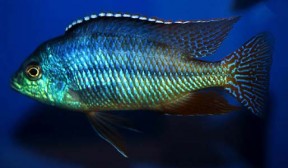Protomelas taeniolatus
Classification
Cichlidae
Distribution
Endemic to Lake Malawi. It has a wide distribution in the lake.
Habitat
It inhabits rocky areas of shallow, clear (no sediment) water.
Maximum Standard Length
8″ (20cm). Larger in nature.
Aquarium SizeTop ↑
48″ x 18″ x 15″ (120cm x 45cm x 37.5cm) – 200 litres.
Maintenance
Use piles of rocks to form lots of caves and hiding places with areas of open space for swimming between. A sandy substrate is ideal.
Water Conditions
Temperature: 75-82°F (24-28°C)
pH: 7.6-8.8
Hardness: 10-25°H
Diet
It feeds mainly on algae and other microrganisms in nature and requires a high fibre diet in the aquarium. A large proportion of the diet should therefore be composed of vegetable matter such as spirulina flake or blanced spinach/lettuce. Live and frozen brine shrimp, Daphnia and bloodworm are useful supplements to this. Meaty foods such as beefheart are detrimental to the fishes’ long term health. It is a greedy fish and is prone to becoming overweight so care must be taken when feeding.
Behaviour and CompatibilityTop ↑
A peaceful species but it is more robust than others in the genus and can even be kept with mbuna. However, more suitable tankmates include Aulonocara, Copadichromis and other peaceful Malawi species. Males are very territorial and a very large tank would be required to keep more than one. It is also better to keep several females per male.
Sexual Dimorphism
The male is larger and much more colourful than the female and has extended dorsal, anal and pelvic fins.
Reproduction
Possible. Maternal mouthbrooder. For the best results, it should be spawned in a species tank. Adult fish tend to be quite expensive so a more feasible option is to start with a group of 6-8 young fish. A 48″x15″ aquarium is an adequate size and this should be furnished as suggested above. Be sure to provide some areas of open sand and flat rock surfaces to act as potential spawning sites. The pH should be around 8.0-8.5 and the temperature 77-80°F. Condition the fish on a good diet of live, frozen and dried foods.
When in condition, the male will form a small temporary territory containing either a flat rock surface or simply an area of the substrate in which he excavates a pit. He will display around this, showing intense colour, and attempt to entice females to mate with him. He can be quite aggressive in his pursuits and it is in order to dissipate this aggression that this species should be spawned in a harem. If there are other species in the tank they will not be permitted to enter the male’s territory. When a female is willing, she will approach the spawning site and lay her eggs there, allowing the male to fertilise them before taking them into her mouth. Once spawning is complete both fish leave the site, the male no longer defending it as a territory.
The female carries the eggs for around 3 weeks before releasing the free swimming fry. She will not eat during this period and can be easily spotted by her distended mouth. If a female is overly stressed, she may spit out the brood prematurely or eat them, so care must be taken if you decide to move the fish in order to avoid fry predation. Some breeders artificially strip the fry from the mother’s mouth at the 2 week stage and raise them from that point as this usually results in a larger number of fry. This method is only recommended for the expert. The fry will accept newly hatched brine shrimp or microworm immediately after they become free swimming.
NotesTop ↑
One of the more popular and readily available Protomelas species in the hobby, P. taeniolatus is very similar to P. fenestratus. Several colour forms of both these species exist. Some of the popular morphs of taeniolatus include “Red Empress”, “Super Red Empress” and “Blue Fire”. It is likely that some of these may be reclassified as distinct species in the future, as they attain different maximum sizes. None of these related species or morphs should be kept together in aquaria as they may hybridise.


